Indoor Games and Activities for Kids When Bored
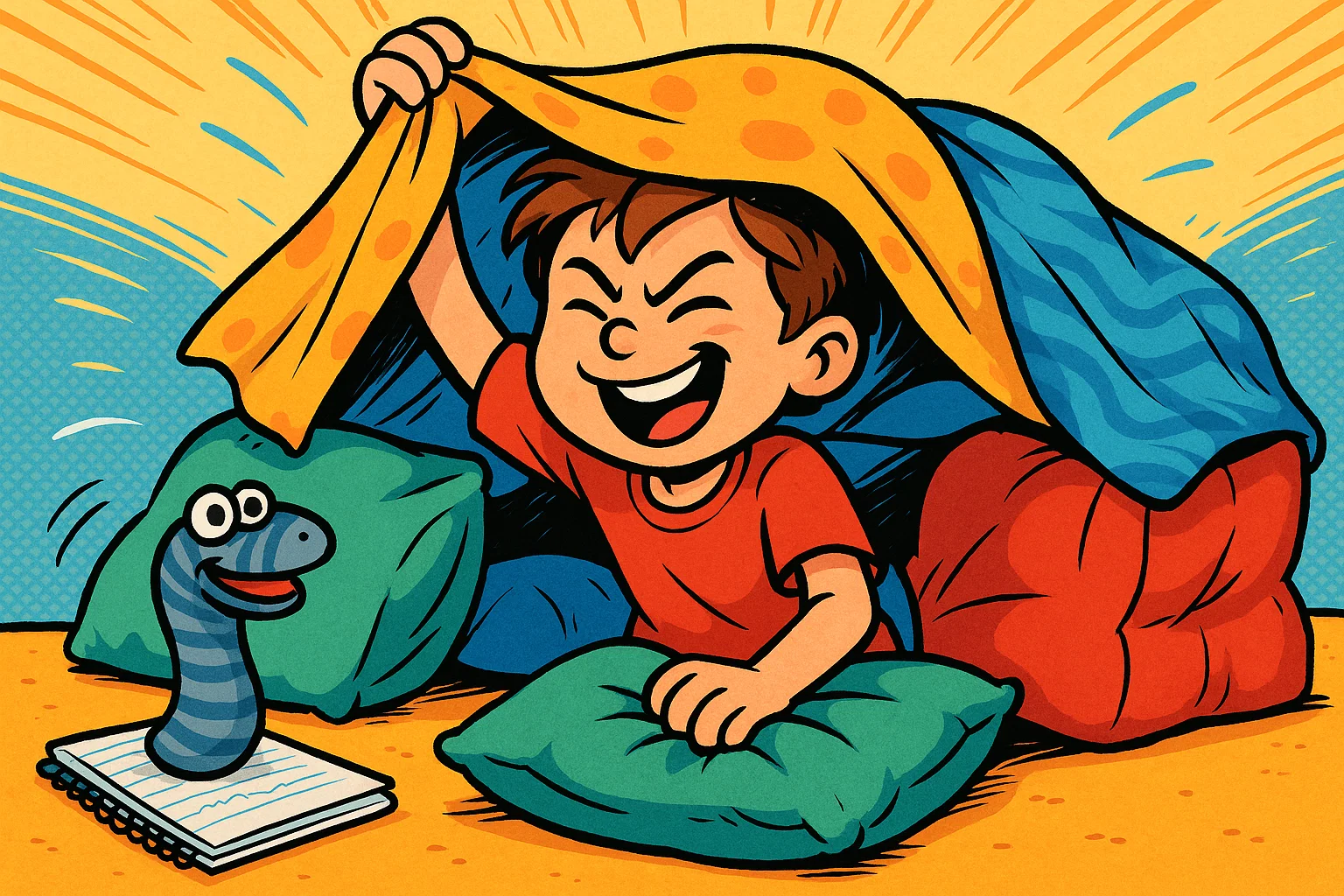
When you hear “I’m bored” for the third time before noon, it’s easy to feel your patience wearing thin. However, boredom isn’t necessarily a problem to solve immediately—it’s an opportunity for kids to develop creativity, problem-solving abilities, and independence.
That said, having a collection of engaging activities for kids ready can transform restless afternoons into memorable experiences. Whether rain keeps everyone inside or you simply need fresh ideas for screen-free time, this guide offers practical games and activities that work around the house without requiring elaborate preparation or expensive supplies.
Screen-free entertainment
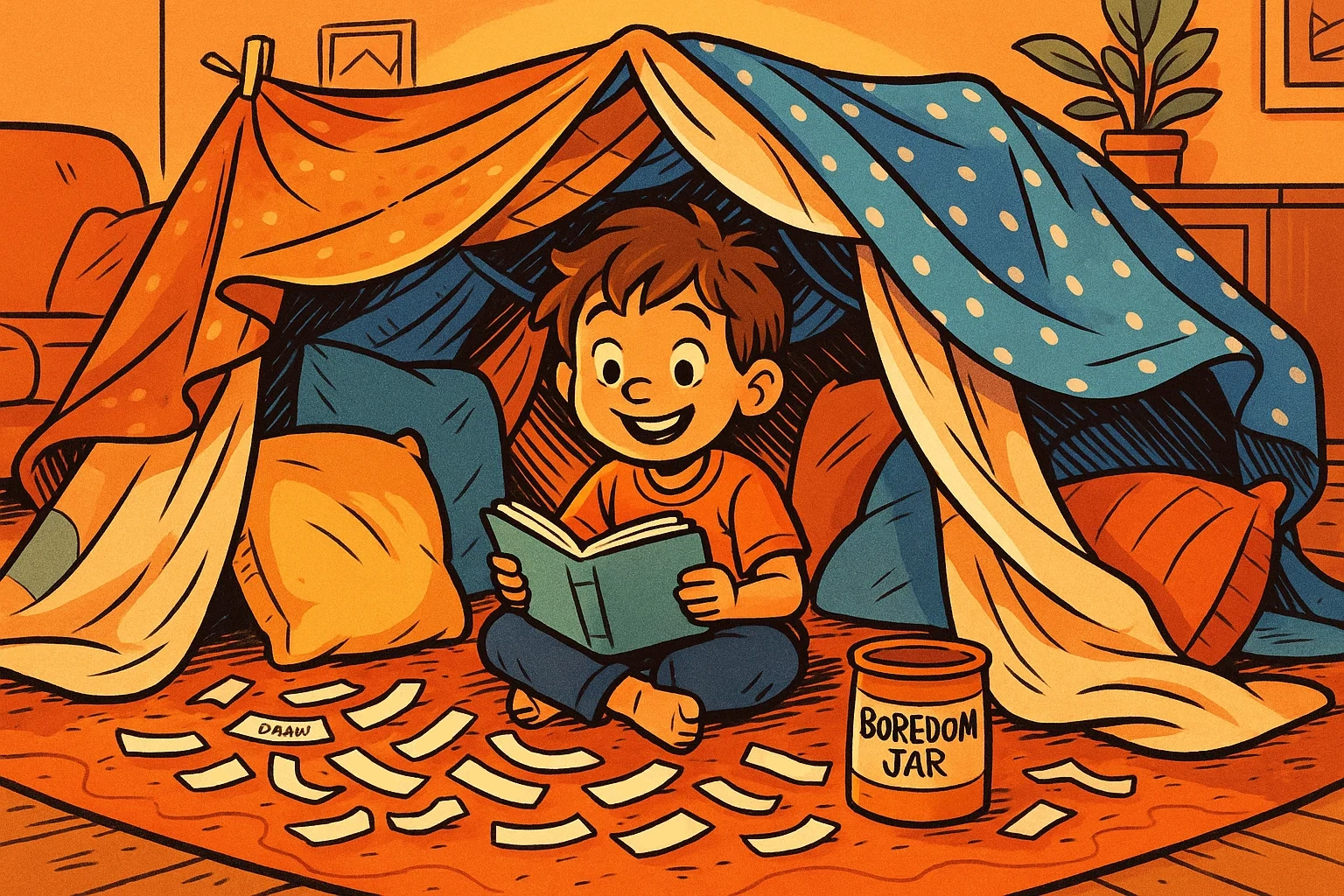
Digital devices dominate modern childhood, making intentional screen-free activities increasingly valuable for development. These options encourage your child to engage their imagination while building communication skills.
Create a Boredom Jar
Fill a mason jar with activity suggestions written on colorful paper strips. When kids complain they’re bored, they can draw a random option. This approach shifts responsibility to the child while making activity selection feel like an exciting game rather than a chore. Include simple activity ideas like:
- Teach the family a new dance move.
- Create an obstacle course.
- Write a letter to grandma.
- Build a towering structure with blocks.
- Read a book upside down.
Build a blanket and pillow fort
Fort construction remains one of the most beloved indoor activities across generations. Drape blankets over furniture, secure edges with books or cushions, and let kids create their private hideaway. Once complete, these structures become versatile spaces—reading nooks, pretend castles, or simply quiet retreats. To build a fort successfully, encourage children to plan their design before gathering materials, which develops spatial reasoning and project planning skills.
Write letters, postcards, or draw for loved ones
Letter writing teaches kids thoughtful communication while creating tangible connections with distant relatives. Provide stationery, markers, and stickers so children can personalize their messages. Grandparents particularly appreciate handwritten notes, and the anticipation of receiving responses teaches patience. This activity also helps develop fine motor skills and literacy in younger children.
Tell stories and fairy tales aloud
Oral storytelling strengthens language development, sequencing abilities, and confidence. Take turns creating adventures where each person adds a sentence or paragraph. You might start with “Once upon a time, a curious rabbit discovered a hidden door…” and see where imagination leads. Recording these stories on a phone creates keepsakes that families treasure for years.
Start a home radio or podcast
Kids love performing, and creating audio content channels that energy productively. Set up a “radio station” where children announce weather, share jokes, conduct family interviews, or play DJ. Older kids might enjoy recording actual podcast episodes discussing their interests, favorite books, or funny family stories. This activity builds public speaking skills and technical literacy.
Active indoor games
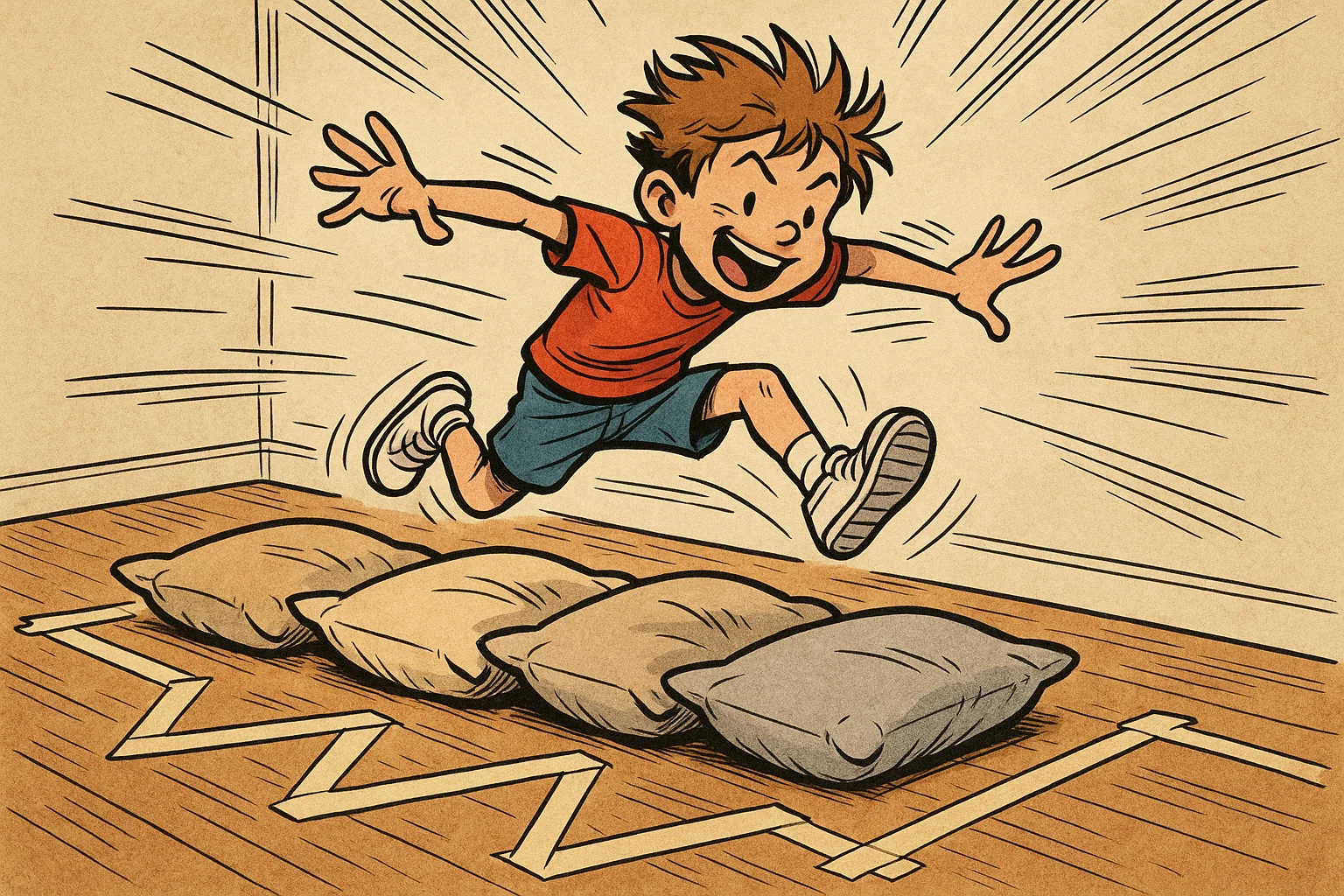
Physical play remains essential even when outdoor space isn’t available. These indoor games help kids burn energy while developing coordination and strength.
Design a home obstacle course
Transform your living room into an adventure challenge using common household items:
- Pillows as stepping stones.
- Yarn or ribbon strung between chair legs for limbo.
- Cushions or towels for jumping stations.
- Cardboard boxes to crawl through.
- Masking tape to create a zig-zag path on the floor.
Time each family member’s completion and encourage kids to redesign the course for new challenges. This type of play develops gross motor skills while allowing creative problem-solving.
Dance contest and flash mobs
Put on energetic music and host spontaneous dance battles. Flash mob planning takes this further—choreograph a simple routine together, then surprise another family member by performing it. Dancing provides excellent cardiovascular exercise while boosting mood through music and laughter. Create contest categories such as:
- Silliest moves
- Most creative
- Best freeze pose
- Robot moves
- Dance like an animal
Sports relays and friendly fitness competitions
Set up relay races with activities like crab walking, hopping on one foot, or balancing a stuffed animal on your head. Create scorecards and track personal bests over time rather than focusing solely on winning. These competitions teach good sportsmanship while building physical endurance in an entertaining format.
Balloon volleyball or tennis
Inflate a balloon and use hands, paper plates, or wooden spoons as rackets. The slow movement of balloons makes this safe for young children and small spaces. Establish simple rules: keep the balloon from touching the ground, hit it only once before your partner’s turn, or count consecutive hits as a team. This game improves hand-eye coordination without the risk of broken lamps.
Paper plate skating
Attach paper plates to kids’ feet with rubber bands or tape, then let them “skate” across hardwood or tile floors. Create skating routines, play freeze dance, or organize races. This surprisingly effective activity strengthens core muscles and balance while feeling more like play than exercise.
Yoga practice and “animal walks”
Introduce basic yoga poses through animal-themed names: downward dog, cat-cow stretch, cobra pose, or butterfly pose. Challenge kids to move across the room like different animals—bear crawls, frog jumps, snake slithers, or crab walks. These activities build flexibility, body awareness, and calm focus, making them particularly valuable before bedtime or after high-energy play.
Creativity and crafts
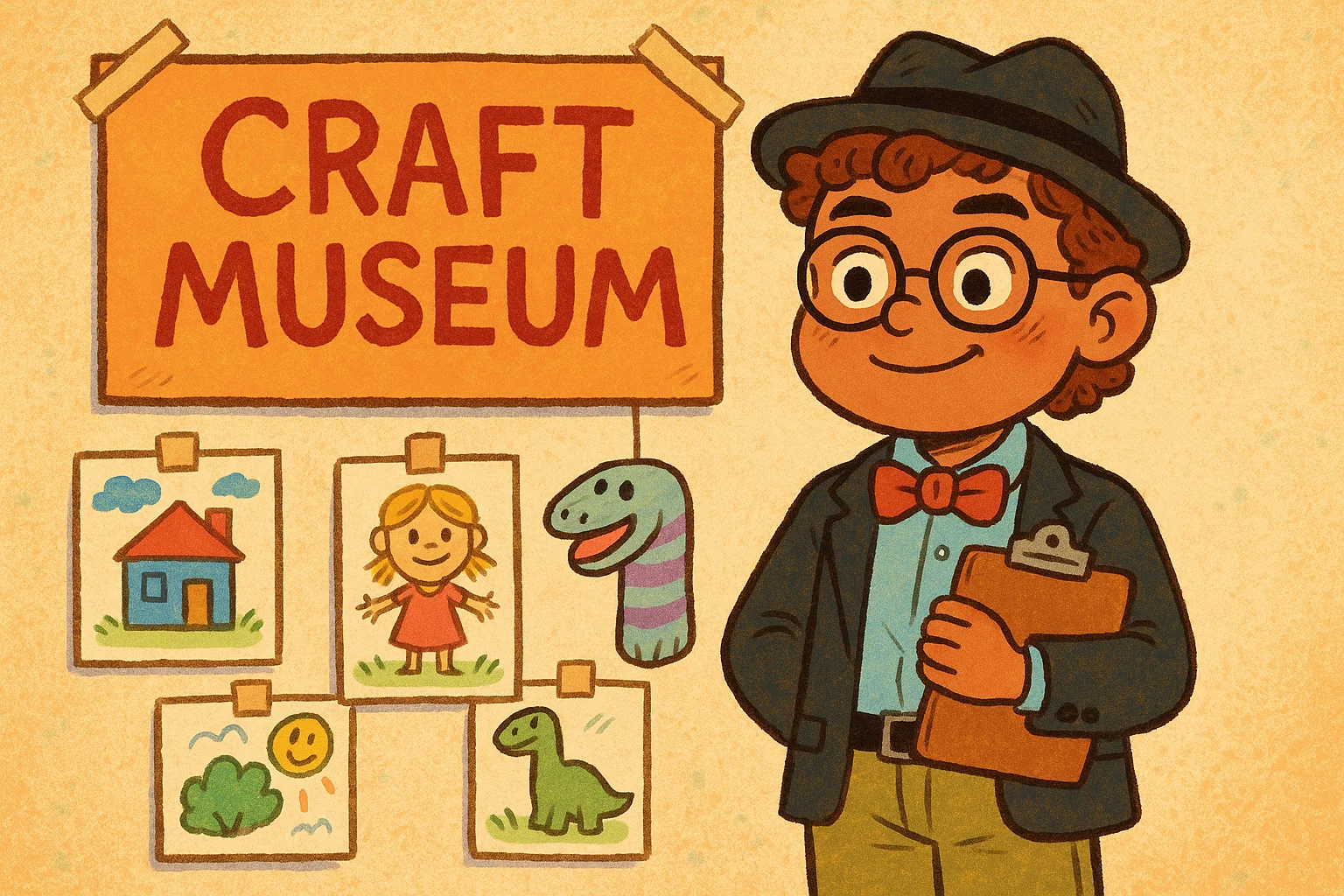
Hands-on creation satisfies kids’ need to make things while developing essential skills:
- Fine motor skills
- Artistic expression
- Focus and patience
These activities use simple materials most families already have at home.
Craft sock puppets or finger puppets
Old socks become characters with just buttons, yarn, and fabric markers. Kids can design entire families or create puppets for favorite stories. Once complete, host puppet shows where children perform for family members. This craft encourages storytelling, character development, and confidence in performance.
Recipes and modeling with homemade playdough/modeling clay
| Ingredient | Amount | Purpose |
| Flour | 2 cups | Base structure |
| Salt | 1 cup | Preservation |
| Water | 1 cup | Binding |
| Food coloring | 2-3 drops | Color variety |
| Vegetable oil | 2 tablespoons | Texture |
| Mix ingredients until smooth, then knead for several minutes. This sensory activity keeps younger children engaged for extended periods while building hand strength necessary for writing. Add cookie cutters, rolling pins, and plastic tools for varied play experiences. |
Making friendship bracelets
Teach kids basic braiding and knotting techniques to create wearable art. Start with three-strand braids using yarn or embroidery floss, then progress to more complex patterns as skills develop. Children love gifting these bracelets to friends and family, learning that handmade gifts carry special meaning. This activity particularly appeals to kids who enjoy detailed, focused work.
Scrapbooking: preserving childhood memories
Gather photos, ticket stubs, drawings, and other mementos to create memory books. Provide glue sticks, decorative paper, stickers, and markers. Encourage kids to write captions explaining what made each moment special. Scrapbooking teaches organizational skills while helping children reflect on experiences and growth. Looking through completed books becomes a cherished family activity.
Organizing a craft museum or gallery
After completing several art projects, dedicate wall space or string clotheslines to display creations. Kids can curate their “museum,” write descriptions of each piece, and give guided tours to family members. This validates their creative efforts while teaching presentation and communication skills. Rotate displays regularly to showcase new works.
Thematic games and theater 🎭
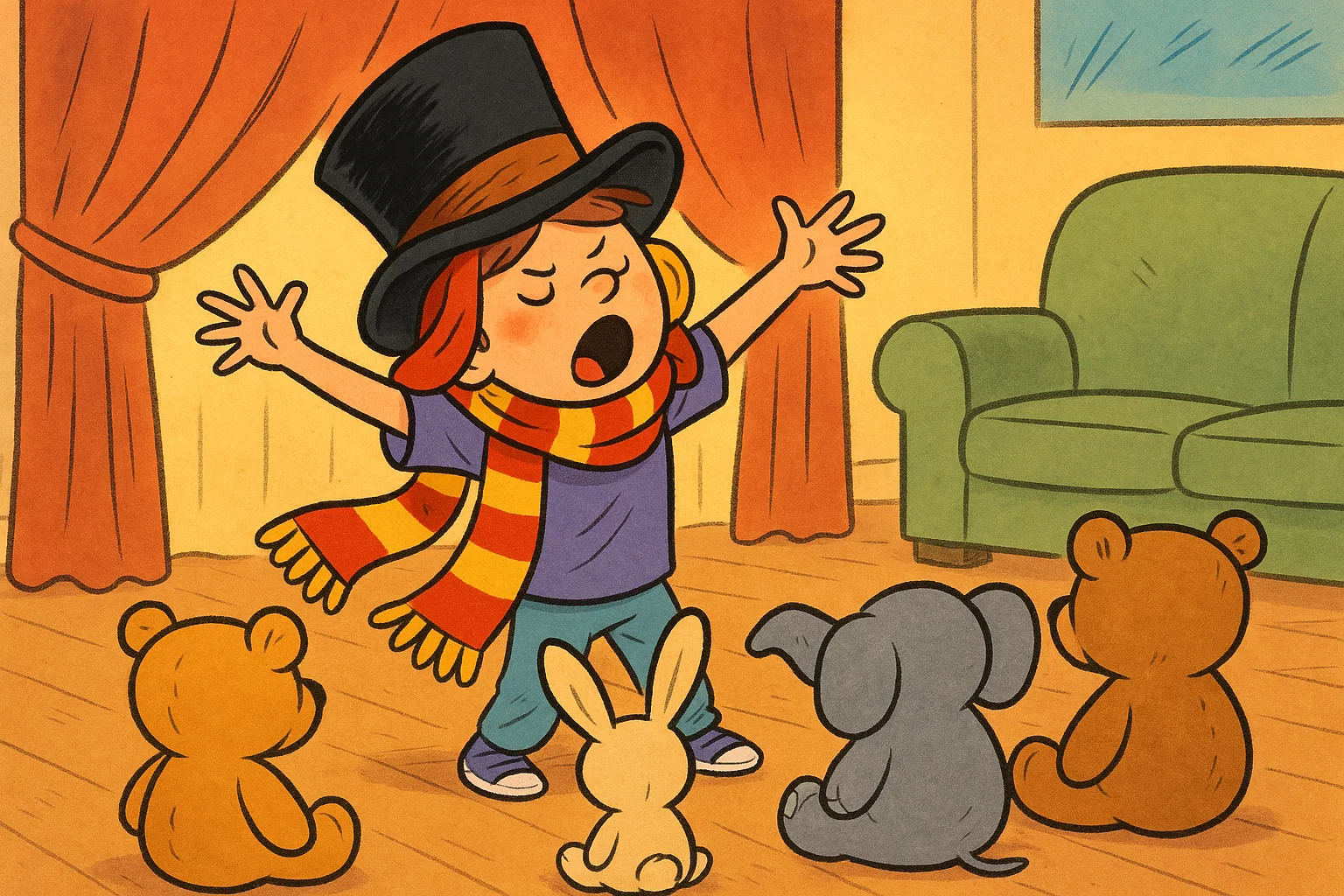
Dramatic play allows kids to explore different roles, emotions, and scenarios in safe, imaginative ways. These activities encourage your child to step into new perspectives.
Put on a play or short performance
Select a favorite book or story, assign roles, and rehearse a performance. Kids can create simple costumes from household items and design programs for their audience. Performances don’t need polish—the value lies in the process of memorizing lines, coordinating with others, and building presentation confidence. Video recordings become treasured family memories.
Film a movie or stop-motion animation
Smartphones make amateur filmmaking accessible to everyone. Kids can script short movies, create storyboards, and direct family members in silly skits. Stop-motion animation using toys or clay figures teaches patience and attention to detail—moving objects incrementally between hundreds of photos to create motion. These projects often span multiple days, providing extended entertainment.
Play dress-up and costume parties
Designate a box for costume materials:
- Old Halloween costumes
- Scarves and fabric scraps
- Hats and accessories (sunglasses, belts)
- Oversized shirts or ties
- Face paint or simple makeup
Let kids create characters and act out scenarios. Theme specific dress-up sessions around historical periods, professions, or favorite books. This type of imaginative play helps kids process real-world experiences and develop empathy by embodying different perspectives.
Invent imaginary creatures
Challenge kids to design entirely new animals by combining features from existing ones. What would a rabbit-elephant hybrid look like? Where would it live? What would it eat? Have them draw their creatures, name them, and write brief descriptions. This activity sparks creativity while reinforcing concepts about adaptation and habitats in a playful context.
Host a tea party or formal dinner
Set up a special meal with nice dishes, cloth napkins, and formal table manners. Kids can help prepare simple snacks, create invitations, and practice etiquette. Stuffed animals or dolls can fill extra seats. These pretend occasions teach social graces, meal planning, and hospitality while feeling special and grown-up.
Science and learning
Educational activities disguised as games teach critical thinking and problem-solving while satisfying natural curiosity about how things work.
Conduct simple science experiments at home
Many experiments use common household items and provide tangible demonstrations of scientific principles. Always supervise experiments and discuss safety procedures beforehand. Try these simple science experiments:
- Baking soda volcanoes
- Growing crystals from salt solutions
- Density demonstrations by layering liquids
- Making Oobleck (non-Newtonian fluid)
- Creating a cloud in a jar
Build a Rube Goldberg Machine
Challenge kids to create elaborate chain reactions that accomplish simple tasks—knocking over a domino that releases a marble that triggers another action. Start with three or four steps, then build complexity as skills develop. This engineering challenge teaches cause-and-effect relationships, persistence when designs fail, and creative problem-solving. Building these machines often consumes hours of focused, productive time.
Educational activities and reading
Establish cozy reading corners with good lighting, comfortable seating, and accessible book storage. Set aside dedicated reading time where the whole family engages with books silently. For younger children, alternate between reading aloud and letting them “read” pictures. Create simple comprehension activities like drawing favorite scenes or discussing character choices. Reading builds vocabulary, concentration, and lifelong learning habits.
Games with board games and team puzzles
Board games teach valuable skills beyond entertainment—turn-taking, strategy, probability, and gracious winning or losing. Jigsaw puzzles develop spatial reasoning and persistence. Work on larger puzzles as family projects over several days, with everyone contributing pieces during passing moments. These activities encourage your child to think ahead and consider consequences of decisions.
Culinary fun and cooking
Kitchen activities teach practical life skills while creating opportunities for math application, following directions, and tasting rewards of effort.
Joint baking and dessert decorating
Simple recipes like cookies, brownies, or rice crispy treats allow kid participation with minimal risk. Children can measure ingredients (practicing fractions), mix batters, and especially enjoy decorating finished products with frosting and sprinkles. The delayed gratification of waiting for baked goods to cook teaches patience, while the final treats taste better because of personal involvement.
Host own “Cooking Show”
Set up a phone or tablet to record kids demonstrating simple recipes. They can explain steps dramatically, taste-test ingredients, and present finished dishes. Even making a sandwich becomes entertainment when presented with enthusiasm and creativity. These videos become funny keepsakes while building confidence and communication skills.
Prepare a simple breakfast or snack
Age-appropriate food preparation builds independence. Younger kids might help make peanut butter crackers or arrange fruit plates. Older children can toast bread, scramble eggs with supervision, or assemble their own sandwiches. These tasks teach responsibility and self-sufficiency while making kids feel capable and mature.
Hunts and riddles
Mystery-solving activities engage analytical thinking while creating excitement and anticipation throughout your home.
Organize treasure hunts and quests
Hide small prizes or treats around the house, then create clues leading from one location to the next. Clues can be simple for young children (“Look where we keep cold milk”) or complex riddles for older kids. Treasure hunts adapt easily to themes—pirate adventures, detective mysteries, or magical quests. These games can keep kids entertained and actively problem-solving for extended periods.
“Close your eyes and guess” game
Place familiar objects in a bag for kids to identify through touch alone. This sensory game sharpens tactile awareness and descriptive vocabulary as children articulate what they feel. Vary difficulty by including similar items—distinguishing between different types of balls or fabric textures. You can expand this sensory game with variations:
- Sounds: Identify common household noises (blender, door creak, running water).
- Smells: Guess spices, herbs, or different foods while blindfolded.
- Taste: Guess mild flavors like fruit slices or specific candy (with supervision).
Telling and inventing riddles
Share classic riddles, then challenge kids to create their own. Writing riddles requires thinking about characteristics and properties of objects in new ways. “I have keys but no locks, space but no room—what am I?” (A keyboard.) Creating good riddles develops critical thinking and wordplay appreciation. Compile favorites in a family riddle book.
Classics and board games
Traditional games endure because they work—simple rules, repeatable play, and genuine fun across age ranges.
Plan a family game night
Dedicate one evening weekly to games without electronic distractions. Rotate who selects the game, ensuring everyone’s preferences get featured. Serve special snacks and make the event feel celebratory. Consistent family game nights create traditions kids remember long into adulthood while strengthening family bonds through shared experiences and laughter.
Classic children’s games: hide and seek, tag
Simple games need no equipment or preparation. Hide and seek teaches spatial awareness and creative thinking about concealment spots. Variations like sardines (one person hides, everyone else finds and squeezes into the hiding spot together) add fresh twists. Indoor tag requires modified rules for safety—perhaps playing freeze tag or using soft “taggers” instead of physical contact.
Party games: “Broken Telephone,” “Hot Potato”
“Broken Telephone” demonstrates how messages distort through repetition—whisper a phrase around a circle and compare the original to the final version. “Hot Potato” using a soft ball or beanbag adds excitement through music and quick reflexes. These games work for mixed age groups and teach good sportsmanship when someone gets “out.”
Hobbies and extra activities
These ongoing projects provide sustained engagement beyond single-afternoon activities, giving kids something to return to repeatedly.
Create a sensory bin
Fill a large container with materials like dried beans, rice, sand, or water beads. Add scoops, cups, small toys, or themed items. Young children spend remarkable time transferring materials between containers, burying and discovering objects, and exploring different textures. This open-ended play supports fine motor development and sensory processing. Establish clear cleanup expectations beforehand.
Start an indoor garden
Growing herbs or vegetables from seeds teaches responsibility through daily care while demonstrating plant life cycles. Even apartment dwellers can grow basil, cherry tomatoes, or lettuce in sunny windows. Kids track growth through photos or drawings, noting changes over weeks. Harvesting and eating homegrown produce creates powerful connections between effort and reward.
Host an “open mic” or comedy show
Encourage kids to prepare jokes, magic tricks, songs, or poetry recitations for family performances. Create a “stage” area with good lighting and a microphone (real or pretend). Performers might feel nervous initially, but regular open mic nights build confidence and public speaking abilities. Audience members practice being supportive, attentive viewers.
Outdoor games
When weather permits, these activities move energy outside while maintaining the spirit of creative, unstructured play.
Ideas for adventures and active fun
Transform ordinary backyards into adventure zones. Set up relay races, create nature scavenger hunts, or establish “base camp” for imaginary expeditions. Outdoor play provides vitamin D, gross motor development, and the freedom to be louder and more physically active than indoor spaces allow. Even small outdoor areas support running, jumping, and climbing.
Paper airplane launching competitions
Fold various airplane designs and test which flies farthest, straightest, or performs best tricks. Kids learn that design matters—wider wings provide stability, pointed noses reduce drag. Hold tournaments with different categories and let kids refine designs between rounds. This activity combines crafts, science, and friendly competition.
Building an “indoor track” for toys
Create roadways using painter’s tape on floors for toy cars, trains, or figurines. Design intersections, parking lots, bridges over pillow “mountains,” or entire miniature cities. This large-scale building project can evolve over days as kids add features and develop storylines for their creations. The tape peels off easily without damaging floors.
Advice for parents
Maximizing the benefits of these activities requires understanding child development and thoughtful facilitation rather than constant direction.
How to match activities by age and preferences
Toddlers need sensory experiences and gross motor activities with immediate results. Preschoolers enjoy pretend play and simple crafts with assistance. Elementary-age children can handle complex projects, competitive games, and activities requiring sustained attention. Observe what naturally engages your child—some kids love active games while others prefer quiet creative work. Honor these preferences rather than forcing participation in activities that don’t suit their temperament.
Ensuring safe and fun activities
Before beginning any activity, survey your space for potential hazards. Move breakable items, ensure adequate space for movement, and establish clear boundaries. Discuss safety rules before starting—scissors stay at the table, forts don’t include jumping, cooking requires adult supervision. Having basic first aid supplies accessible provides peace of mind. Remember that some mess indicates genuine engagement—focus on protecting truly valuable items while allowing creative freedom.
Benefits of games and entertainment for development
Physical games build strength, coordination, and body awareness. Creative activities develop fine motor skills, spatial reasoning, and artistic expression. Pretend play enhances emotional intelligence and perspective-taking. Problem-solving activities strengthen executive function and persistence. When kids engage in these activities, they’re not just passing time—they’re building foundational skills for academic success and life competence.
